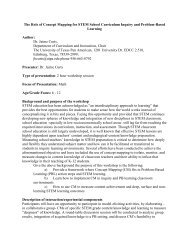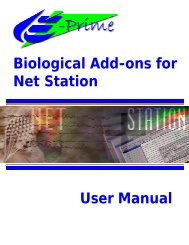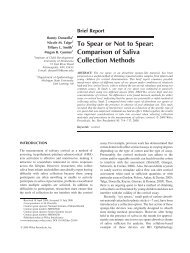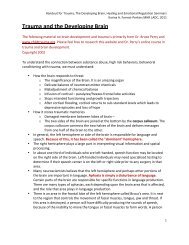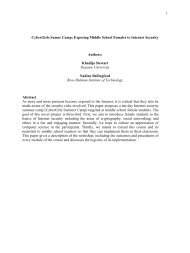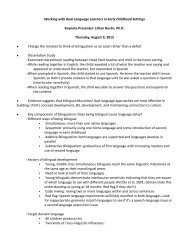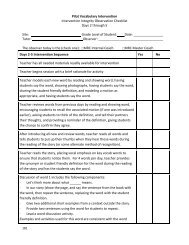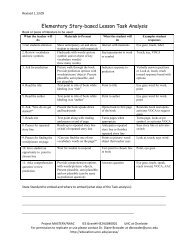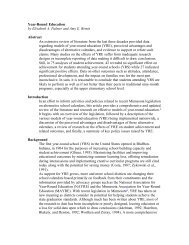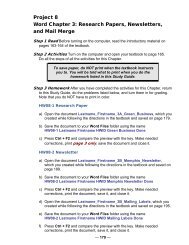Introduction to Positive Ways of Intervening with Challenging Behavior
Introduction to Positive Ways of Intervening with Challenging Behavior
Introduction to Positive Ways of Intervening with Challenging Behavior
Create successful ePaper yourself
Turn your PDF publications into a flip-book with our unique Google optimized e-Paper software.
1) A card listing the goals and leaving space for each interval can be carried by the student or held by the teacher<br />
(this is very useful if the student goes <strong>to</strong> different classrooms). The points earned for each interval would be<br />
entered by the teacher after each interval in the appropriate space.<br />
2) A chart can be posted in the room (on the student's desk or near the teacher’s desk) in which students’ points<br />
are tracked. In this way, a student can see his or her progress over time. Keeping formal records is very<br />
important. This will help prevent misunderstandings and disagreements about the rules.<br />
How can students use their <strong>to</strong>kens?<br />
When setting the <strong>to</strong>ken economy, it should be decided, <strong>with</strong> input from the student, what the student will be able<br />
<strong>to</strong> "buy" <strong>with</strong> his or her <strong>to</strong>kens and how <strong>of</strong>ten he or she will be able <strong>to</strong> cash them in. This is critical since some<br />
students may give up if they do not have the opportunity <strong>to</strong> earn some reward each day. In such cases, you should<br />
structure the point system so that it is possible <strong>to</strong> earn enough points <strong>to</strong> trade each day. For example, if it is<br />
possible <strong>to</strong> earn 40 points per day, 30 points may be worth 15 minutes <strong>of</strong> computer time which the student could<br />
"buy" at the end <strong>of</strong> each day. Other students may be more motivated by bigger reinforcers, i.e., at least 30 points<br />
each day for a week being worth no math homework for the weekend.<br />
Make sure that you allow the student <strong>to</strong> spend his or her own <strong>to</strong>kens. Do not do this for him or her.<br />
Can a <strong>to</strong>ken economy be modified?<br />
A <strong>to</strong>ken economy can and should be modified throughout the year. This includes modifying goals and objectives<br />
as well as reinforcers available.<br />
Over time, students should begin <strong>to</strong> consistently achieve the targeted goals. At this point, you should begin <strong>to</strong><br />
reassess the areas in which they need improvement. You should begin working <strong>with</strong> the student <strong>to</strong> set new goals<br />
or longer intervals, not forgetting <strong>to</strong> give congratulations and praise for "graduating" from the original/prior<br />
program.<br />
Conversely, not earning enough <strong>to</strong>kens <strong>to</strong> get rewards can result in the student becoming frustrated or giving<br />
up. In such instances, changes such as goal modification, shortened time intervals, or targeting fewer goals need<br />
<strong>to</strong> be made.<br />
What about response cost in a <strong>to</strong>ken economy?<br />
Some people include a form <strong>of</strong> "response cost" in their <strong>to</strong>ken economy. This involves penalizing students for<br />
inappropriate behavior by taking away <strong>to</strong>kens they have earned. The ethics <strong>of</strong> taking away what a student has<br />
fairly earned is questionable. Also, a threat <strong>to</strong> the student is implicit in response cost. Response cost may lead <strong>to</strong> a<br />
student behaving appropriately only out <strong>of</strong> fear or anxiety <strong>of</strong> losing points or <strong>to</strong>kens. Furthermore, it may lead <strong>to</strong><br />
power struggles that escalate and become setting events for other undesired behaviors.<br />
How can I phase out a <strong>to</strong>ken economy?<br />
One way is by changing the rewards from which students may choose. For instance, rather than earning a candy<br />
bar for appropriate behavior, let the student take the attendance <strong>to</strong> the <strong>of</strong>fice every morning, contingent upon<br />
continued appropriate behavior. Focus can be moved from tangible rewards <strong>to</strong> focusing on grade improvement,<br />
classroom status, and providing more social reinforcement. You can also reduce the number <strong>of</strong> <strong>to</strong>kens that a<br />
student earns, requiring the student <strong>to</strong> do more work for the same number <strong>of</strong> <strong>to</strong>kens.<br />
In some cases, you may find that no matter what you do, it seems that as soon as the <strong>to</strong>ken economy is<br />
dropped, so is the appropriate behavior. In this case, the <strong>to</strong>ken economy has become a behavior management <strong>to</strong>ol<br />
rather than a behavior modification <strong>to</strong>ol.<br />
It is recommended that other behavioral interventions be used in conjunction <strong>with</strong> the <strong>to</strong>ken economy<br />
(see "Contingency Contracts," "Cuing," "Cooperative Learning," “Self-Moni<strong>to</strong>ring," "Differential<br />
Reinforcement," "Modeling," "<strong>Positive</strong> Programming," and "Shaping").




